
Warcraft III: Reign of Chaos is a high fantasy real-time strategy computer video game developed and published by Blizzard Entertainment released in July 2002. It is the second sequel to Warcraft: Orcs & Humans, after Warcraft II: Tides of Darkness, the third game set in the Warcraft fictional universe, and the first to be rendered in three dimensions. An expansion pack, The Frozen Throne, was released in July 2003. Warcraft III is set several years after the events of Warcraft II, and tells the story of the Burning Legion's attempt to conquer the fictional world of Azeroth with the help of an army of the Undead, led by fallen paladin Arthas Menethil. It chronicles the combined efforts of the Human Alliance, Orcish Horde, and Night Elves to stop them before they can corrupt the World Tree.
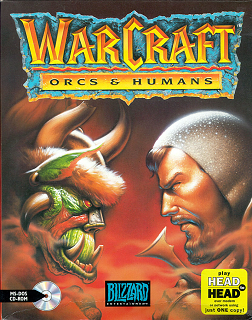
Warcraft: Orcs & Humans is a real-time strategy game (RTS) developed and published by Blizzard Entertainment, and published by Interplay Productions in Europe. It was released for MS-DOS in North America on 15 November 1994, and for Mac OS in early 1996. The MS-DOS version was re-released by Sold-Out Software in 2002.

World of Warcraft (WoW) is a massively multiplayer online role-playing game (MMORPG) released in 2004 by Blizzard Entertainment. Set in the Warcraft fantasy universe, World of Warcraft takes place within the world of Azeroth, approximately four years after the events of the previous game in the series, Warcraft III: The Frozen Throne. The game was announced in 2001, and was released for the 10th anniversary of the Warcraft franchise on November 23, 2004. Since launch, World of Warcraft has had nine major expansion packs: The Burning Crusade (2007), Wrath of the Lich King (2008), Cataclysm (2010), Mists of Pandaria (2012), Warlords of Draenor (2014), Legion (2016), Battle for Azeroth (2018), Shadowlands (2020), and Dragonflight (2022). Three further expansions, The War Within, Midnight, and The Last Titan, were announced in 2023.

Warcraft III: The Frozen Throne is the expansion pack for Warcraft III: Reign of Chaos, a real-time strategy video game by Blizzard Entertainment. It was released worldwide on July 1, 2003, for Microsoft Windows and Mac OS X. The Frozen Throne builds upon the story of Reign of Chaos and depicts the events after the main game's conclusion. The single-player unfolds from the perspective of two new protagonists—the Night Elf warden Maiev Shadowsong and the Blood Elf prince Kael'Thas—as well as returning protagonist Arthas Menethil. Additionally, the expansion contains Act I of a separate Horde campaign that is independent from the main storyline with Blizzard releasing Acts II and III via patch in December 2003, taking in player feedback of Act I when developing these chapters.
Warcraft is a franchise of video games, novels, and other media created by Blizzard Entertainment. The series is made up of six core games: Warcraft: Orcs & Humans, Warcraft II: Tides of Darkness, Warcraft III: Reign of Chaos, World of Warcraft, Hearthstone, and Warcraft Rumble. The first three of these core games are in the real-time strategy genre, where opposing players command virtual armies in battle against each other or a computer-controlled enemy. The fourth and best-selling title of the franchise is a massively multiplayer online role-playing game (MMORPG), where players control their character and interact with each other in a virtual world.

World of Warcraft: The Burning Crusade is the first expansion set for the MMORPG World of Warcraft. It was released on January 16, 2007 at local midnight in Europe and North America, selling nearly 2.4 million copies on release day alone and making it, at the time, the fastest-selling PC game released at that point. Approximately 3.53 million copies were sold in the first month of release, including 1.9 million in North America, nearly 1.6 million in Europe, and over 100,000 copies in Australia.

World of Warcraft: Rise of the Horde is a novel by Christie Golden set in the Warcraft Universe. It was published in December 2006. Golden also has a commitment with Blizzard Entertainment and Simon & Schuster to write a StarCraft trilogy. Originally presumed to be the sequel to her previous 2001 book, Warcraft: Lord of the Clans, it depicts the draenei's escape from Argus and the rise of the Horde, following their shift from a shamanic race to a warmongering one. The book features major Warcraft characters, such as Durotan, Ner'zhul, Gul'dan, Orgrim Doomhammer, Kil'jaeden, and Velen. The story tells of how the orc clans and the noble draenei slowly become enemies due to deception and arrogance, and shows the downward spiral into which the orcs are thrown, and explores the role that demonic forces play in the Horde. It also expands on the origin of the Burning Legion, and the events preceding the first game of the Warcraft series.

World of Warcraft: Tides of Darkness is a fantasy novel written by Aaron S. Rosenberg and published by Simon & Schuster Pocket Star Books, a division of Viacom. The novel is based on Blizzard Entertainment's Warcraft universe, and is a novelization of the RTS PC game: Warcraft II: Tides of Darkness (1995). It was made available on August 28, 2007.
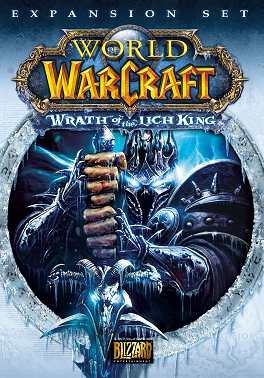
World of Warcraft: Wrath of the Lich King is the second expansion set for the massively multiplayer online role-playing game (MMORPG) World of Warcraft, following The Burning Crusade. It launched on November 13, 2008 and sold 2.8 million copies within the first day, making it the fastest selling computer game of all time released at that point. The game added a substantial amount of new content into the game world, including the new continent of Northrend, home of The Lich King Arthas and his undead minions. In order to advance through Northrend, players were required to reach at least level 68, with the level cap for the expansion being 80. The first hero class was introduced, the Death Knight, that starts at level 55.
World of Warcraft, or WoW, is set in a fictional universe, its primary setting being the planet of Azeroth. The first expansion, The Burning Crusade, introduced a second planet, Outland. Wrath of the Lich King and Cataclysm expanded upon Azeroth and respectively added Northrend, the frigid northern continent of Azeroth, and drastically changed various other continents by destroying some and unveiling new ones. The next expansion, Mists of Pandaria, added Pandaria, the southern continent previously hidden behind a perennial mist cover. Warlords of Draenor introduced the planet of Draenor, a version of Outland in a different timeline before its partial destruction. The Legion expansion took adventurers to the Broken Isles, an island chain near the Maelstrom in the middle of the Great Sea, and the damaged planet Argus, the headquarters of the Burning Legion. The seventh expansion, Battle for Azeroth, added two new island continents to the center of Azeroth: Kul Tiras and Zandalar. The latest expansion, Shadowlands, introduced the eponymous Shadowlands, a realm composed of five major zones: Bastion, Maldraxxus, Ardenweald, Revendreth, and the Maw.
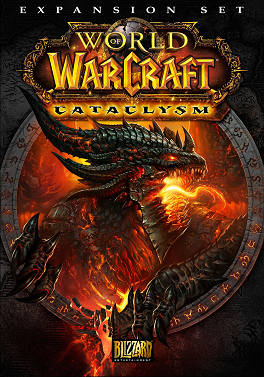
World of Warcraft: Cataclysm is the third expansion set for the massively multiplayer online role-playing game (MMORPG) World of Warcraft, following Wrath of the Lich King. It was officially announced at BlizzCon on August 21, 2009, although dataminers and researchers discovered details before it was announced by Blizzard. The expansion was released on December 7, 2010.

Warcraft II: Tides of Darkness is a fantasy real-time strategy computer game developed by Blizzard Entertainment and released for MS-DOS and Microsoft Windows in 1995 and Mac OS in 1996 by Blizzard's parent, Davidson & Associates. A sequel to Warcraft: Orcs & Humans, the game was met with positive reviews and won most of the major PC gaming awards in 1996. In 1996, Blizzard released an expansion pack, Warcraft II: Beyond the Dark Portal, for DOS and Mac OS, and a compilation, Warcraft II: The Dark Saga, for the PlayStation and Sega Saturn. The Battle.net edition, released in 1999, included Warcraft II: Beyond the Dark Portal, provided Blizzard's online gaming service, and replaced the MS-DOS version with a Windows one.

World of Warcraft: Mists of Pandaria is the fourth expansion set for the massively multiplayer online role-playing game (MMORPG) World of Warcraft, following Cataclysm. It was announced on October 21, 2011, by Chris Metzen at BlizzCon 2011, and was released on September 25, 2012.
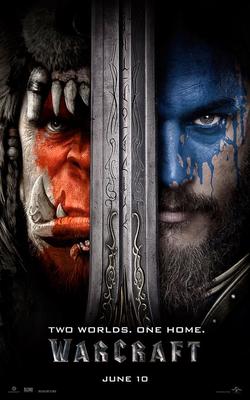
Warcraft is a 2016 American action fantasy film based on the video game series of the same name. Directed by Duncan Jones, who co-wrote with Charles Leavitt, it stars Travis Fimmel, Paula Patton, Ben Foster, Dominic Cooper, Toby Kebbell, Ben Schnetzer, Robert Kazinsky, and Daniel Wu. The film follows Anduin Lothar of Stormwind and Durotan of the Frostwolf clan as heroes set on opposite sides of a growing war, as the warlock Gul'dan leads the Horde to invade Azeroth using a magic portal. Together, a few human heroes and dissenting Orcs must attempt to stop the true evil behind this war and restore peace.

World of Warcraft: Warlords of Draenor is the fifth expansion set to the massively multiplayer online role-playing game (MMORPG) World of Warcraft, following Mists of Pandaria. It was announced on November 8, 2013 at BlizzCon 2013. The expansion was released on November 13, 2014.
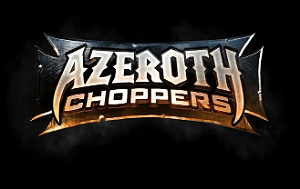
Azeroth Choppers was a weekly web series by Blizzard Entertainment that ran from April 17 to June 5, 2014. It featured Paul Teutul, Jr. and his company Paul Jr. Designs building motorcycles based on Blizzard's long-running MMORPG World of Warcraft.

World of Warcraft: Legion is the sixth expansion set in the massively multiplayer online role-playing game (MMORPG) World of Warcraft, following Warlords of Draenor. It was announced on August 6, 2015 at Gamescom 2015. The expansion was released on August 30, 2016.

World of Warcraft: Battle for Azeroth is the seventh expansion pack for the massively multiplayer online role-playing game (MMORPG) World of Warcraft, following Legion. It was announced at BlizzCon on November 3, 2017. In contrast to previous expansions, which went live at midnight in each time zone, Battle for Azeroth had a simultaneous release for all regions, corresponding to midnight Central European Summer Time on August 14, 2018.

Anduin Llane Wrynn is a fictional character who appears in the Warcraft series of video games by Blizzard Entertainment. First appearing in the original launch of World of Warcraft in 2004, Anduin is the son of Tiffin and Varian Wrynn, and the king of the human kingdom of Stormwind. Following Varian's disappearance, young Anduin is crowned king of Stormwind. He succeeds his father following his death in World of Warcraft: Legion, as well as his position as leader of the Alliance. Anduin also appears as a playable character in the crossover multiplayer online battle arena game Heroes of the Storm. The character is voiced by Josh Keaton.
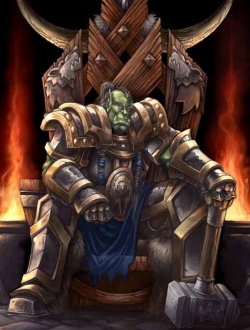
Thrall, born as Go'el, is a fictional character who appears in the Warcraft series of video games by Blizzard Entertainment. Within the series, Thrall is an orc shaman who served for a time as a Warchief of the Horde, one of the major factions of the Warcraft universe, as well as the leader of a shaman faction dedicated to preserving the balance between elemental forces in the world of Azeroth known as the Earthen Ring. Originally introduced in promotional material released by Blizzard Entertainment as the protagonist of the canceled video game Warcraft Adventures: Lord of the Clans, which was co-developed by Blizzard and Animation Magic from 1996 until 1998, Thrall's first proper appearance is in the 2001 novelization of the canceled video game's narrative authored by American novelist Christie Golden. The novel's story is set during his youth, where he is depicted as a slave who was raised by an abusive human military officer, but eventually rebelled and escaped captivity.


















